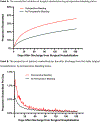Perioperative bleeding and outcomes after noncardiac surgery
- PMID: 36801264
- PMCID: PMC10164115
- DOI: 10.1016/j.ahj.2023.02.008
Perioperative bleeding and outcomes after noncardiac surgery
Abstract
Background: Perioperative bleeding is a common and potentially life-threatening complication after surgery. We sought to identify the frequency, patient characteristics, causes, and outcomes of perioperative bleeding in patients undergoing noncardiac surgery.
Methods: In a retrospective cohort study of a large administrative database, adults aged ≥45 years hospitalized for noncardiac surgery in 2018 were identified. Perioperative bleeding was defined using ICD-10 diagnosis and procedure codes. Clinical characteristics, in-hospital outcomes, and first hospital readmission within 6 months were assessed by perioperative bleeding status.
Results: We identified 2,298,757 individuals undergoing noncardiac surgery, among which 35,429 (1.54%) had perioperative bleeding. Patients with bleeding were older, less likely to be female, and more likely to have renal and cardiovascular disease. All-cause, in-hospital mortality was higher in patients with vs without perioperative bleeding (6.0% vs 1.3%; adjusted OR [aOR] 2.38, 95% CI 2.26-2.50). Patients with vs without bleeding had a prolonged inpatient length of stay (6 [IQR 3-13] vs 3 [IQR 2-6] days, P < .001). Among those who were discharged alive, hospital readmission was more common within 6 months among patients with bleeding (36.0% vs 23.6%; adjusted HR 1.21, 95% CI 1.18-1.24). The risk of in-hospital death or readmission was greater in patients with vs without bleeding (39.8% vs 24.5%; aOR 1.33, 95% CI 1.29-1.38). When stratified by revised cardiac risk index , there was a stepwise increase in surgical bleeding risk with increasing perioperative cardiovascular risks.
Conclusions: Perioperative bleeding is reported in 1 out of every 65 noncardiac surgeries, with a higher incidence in patients at elevated cardiovascular risk. Among postsurgical inpatients with perioperative bleeding, approximately 1 of every 3 patients died during hospitalization or were readmitted within 6-months. Strategies to reduce perioperative bleeding are warranted to improve outcomes following non-cardiac surgery.
Keywords: Bleeding; Mortality; Outcomes; Perioperative; Readmission; Rehospitalization; Surgery; Survival.
Published by Elsevier Inc.
Conflict of interest statement
Conflict of interest Dr Smilowitz serves on an advisory board for Abbott Vascular. The remainder of the authors report no conflicts of interest to disclose.
Figures




References
-
- Roshanov PS, Eikelboom JW, Sessler DI, et al. Bleeding Independently associated with Mortality after noncardiac Surgery (BIMS): an international prospective cohort study establishing diagnostic criteria and prognostic importance. British journal of anaesthesia. 2021;126(1):163–171. - PubMed
-
- Devereaux PJ, Mrkobrada M, Sessler DI, et al. Aspirin in patients undergoing noncardiac surgery. N Engl J Med. 2014;370(16):1494–1503. - PubMed
-
- Devereaux PJ, Marcucci M, Painter TW, et al. Tranexamic Acid in Patients Undergoing Noncardiac Surgery. N Engl J Med. 2022. - PubMed
Publication types
MeSH terms
Grants and funding
LinkOut - more resources
Full Text Sources
Medical

